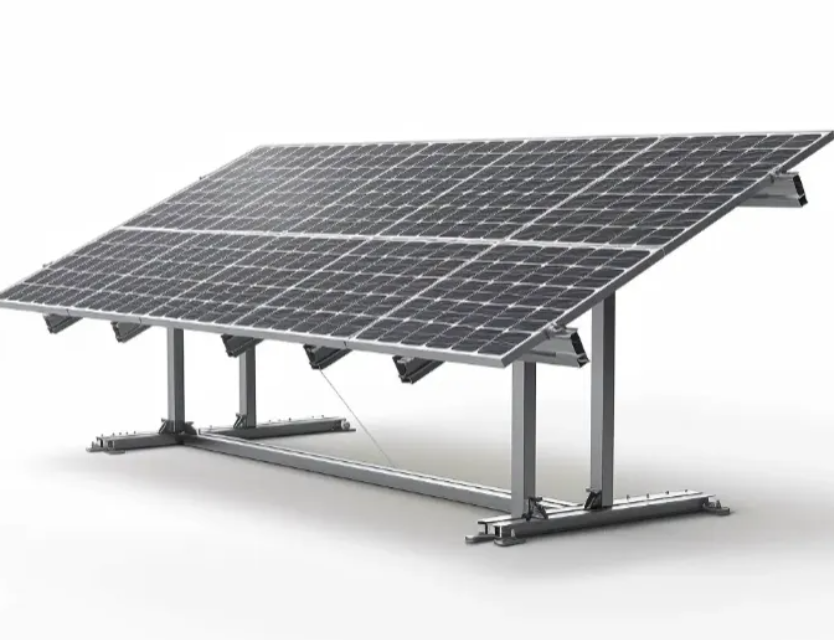के फायदे सोलर ग्राउंड माउंटिंग सिस्टम बड़े पैमाने की परियोजनाओं के लिए
उच्च ऊर्जा आउटपुट और कुशलता
सोलर ग्राउंड माउंट सिस्टम अटलांटा में बहुत प्रसिद्ध हो चुके हैं क्योंकि वे सूरज की रोशनी को अधिकतम तक पहुँचते हैं और आपकी ऊर्जा उत्पादन क्षमता को बढ़ाते हैं। इन तरह के सिस्टम एक आम छत पर स्थापित सिस्टम की तुलना में सौर ऊर्जा उत्पादन में 20 प्रतिशत की वृद्धि कर सकते हैं। यह बड़े सौर पैनलों को स्थान देंगे, जिससे अधिक ऊर्जा उत्पन्न होगी। परिणामस्वरूप, बिजली की समानयित लागत (LCOE) घटेगी और फोटोवोल्टाइक अभियान अधिक सस्ता होगा। ग्राउंड माउंट सिस्टम पैनलों की झुकाव और दिशा को समायोजित करने की उपयोगी क्षमता रखते हैं। यह लचीलापन वर्ष के मौसमी परिवर्तनों को ध्यान में रखते हुए अधिकतम प्रदर्शन के लिए महत्वपूर्ण है। ऐसा ऊर्जा उत्पादन का समर्थन वर्षभर के लिए महत्वपूर्ण है, जो मेगा सौर परियोजनाओं के लिए आवश्यक है।
विस्तारित ऊर्जा आवश्यकताओं के लिए स्केलिंग
ग्राउंड Маunting संरचनाओं के महत्वपूर्ण संपत्तियों में से एक है कि इसमें पैमाने पर बढ़ावा देने के लिए मॉड्यूलर डिजाइन होता है। वे आसानी से बढ़ाए जा सकते हैं ताकि बढ़ती ऊर्जा की जरूरतों का समर्थन कर सकें और कम अवरोध के साथ बढ़ती बिजली की मांग का समर्थन कर सकें। यह क्षमता मेगा सोलर परियोजनाओं के लिए अत्यधिक उपयोगी है, जहाँ चरणबद्ध रूप से कमीशनिंग की जाती है। इन प्रणालियों के समाधान पैमाने पर बढ़ाए जा सकते हैं और उद्योग और शहरी क्षेत्रों में बढ़ती बिजली की मांग के लिए उपयुक्त हैं। जैसे-जैसे ऊर्जा की आवश्यकताएं बढ़ती हैं, ग्राउंड माउंटेड सोलर प्रणालियां आपको छोटे, प्रबंधनीय भागों में क्षमता की मात्रा को बढ़ाने की लचीलापन प्रदान करती हैं, ताकि आप अपनी ऊर्जा की आवश्यकताओं को जितना संभव हो सके उतना कुशल और प्रभावी ढंग से पूरा कर सकें।
आदर्श भूमि उपयोग और स्थान का उपयोग
सोलर ग्राउंड माउंटिंग सिस्टम का आदर्श भूमि उपयोग एक और महत्वपूर्ण फायदा है और यह विशेष रूप से बेकार या अनवकाशित भूमि के लिए है। इतिहास में, जो बड़ी साइटें ज़ोनिंग मैप पर सोलर फार्म के लिए छोड़ दी गई हैं, वे विकसित नहीं की जाती हैं और सोलर परियोजनाएँ अन्य भूमि उपयोगों को प्रभावित नहीं करती हैं। इसके अलावा, एग्रिवोल्टेक्सिक्स के माध्यम से भूमि की कुशलता में सुधार किया जा सकता है, जो कृषि को फोटोवोल्टाइक्स के साथ जोड़ता है। सोलर को कृषि के साथ सह-स्थानांतरित करने से भूमि को अपने पूरे विकास के लिए उपयोग किया जा सकता है, स्थानीय अर्थव्यवस्था को समर्थित करता है। यह समझौता न केवल ऊर्जा उत्पादन को बढ़ाता है, बल्कि सustain विकास को बढ़ावा देता है, सोलर पावर प्लांट में प्रौद्योगिकी और प्रकृति के बीच एक अच्छी तरह से जुड़े हुए संयोजन को लागू करता है।
सौर ग्राउंड माउंटिंग बनाम छत पर प्रणालियाँ: मुख्य तुलनाएँ
इंस्टॉलेशन लचीलापन और भूमि रूप अनुकूलन
स्वतंत्र सोलर पैनलों को रूफ़ पर लगाए गए पैनलों की तुलना में अधिक स्थापना के अवसर होते हैं और वे चट्टानों की बढ़िया श्रृंखला को अच्छी तरह से समायोजित कर सकते हैं। ऐसे ही कुछ प्रणालियाँ हैं जो किसी भी तरह की भूमि पर रखी जा सकती हैं, चाहे वे क्षेत्र या रेगिस्तान हों या ब्राउनफील्ड्स। यह लचीलापन खराब या असमान चट्टानों में विशेष रूप से फायदेमंद होता है जहाँ रूफ़ पर स्थापना अप्राक्टिकल होती है। इसके अलावा, भूमि पर स्थापित प्रणालियाँ आम तौर पर तेजी से लगाई जा सकती हैं और उनमें कम संरचनात्मक निर्भरता होती है क्योंकि आपको मौजूदा छत को फिर से डिज़ाइन करने की जरूरत नहीं पड़ती है। ऐसा लचीलापन न केवल बिजली के उत्पादन को अधिकतम कर सकता है, बल्कि इससे फ़ेलो को आसान बनाया जा सकता है, जिससे भूमि-स्थापित प्रणालियाँ विभिन्न भौगोलिक जलवायुओं में पसंद की जाने वाली विकल्प बन जाती हैं।
परियोजना और लंबे समय तक की प्रदर्शन क्षमता
ग्राउंड-माउंटेड सोलर सिस्टम: आसानी से मेंटेनेंस करने योग्य और स्थायी ग्राउंड-माउंटेड सोलर सिस्टम। जहाँ स्थान उपलब्ध है, एक ग्राउंड-माउंटेड सोलर सिस्टम पर्याप्त व्यापारिक या संपत्ति स्थान के कारण एक और फायदा है। ग्राउंड स्थापनाओं को बढ़ावा मिलता है क्योंकि उनमें पहुंचना और जांचना आसान होता है, जिससे नियमित मेंटेनेंस होता है बिना इमारतों को नुकसान पहुंचाए। यह आसान पहुंच सिस्टम को चरम संचालन प्रदर्शन तक पहुंचाती है, डाउनटाइम को कम करती है, कुशलता में सुधार करती है और निवेश पर बढ़िया रिटर्न देती है। साहित्य में प्रस्तुत किया गया है कि ग्राउंड माउंटेड PV सिस्टम की विफलता की संभावना कम होती है क्योंकि उनमें संचालन पहुंच आसान होती है। यह ऊर्जा उत्पादन की भरोसेमंदी बढ़ाती है और सोलर परियोजनाओं की लंबी अवधि को सुनिश्चित करती है। सरल मेंटेनेंस की आवश्यकताओं के साथ, ग्राउंड-माउंट सिस्टम बड़े पैमाने पर सोलर परियोजनाओं में लंबे समय तक कुशल उपयोग के लिए एक मजबूत वैकल्पिक है।
औद्योगिक के लिए लागत-कुशलता और ROI अनुप्रयोग
कम लगानी और संचालन लागत
जमीन-पर लगाए गए सोलर प्रणाली का आर्थिक मामला बनाने में काफी मजबूती होती है, खासकर औद्योगिक संरचनाओं में। उन्हें भी लगाने में आसानी होती है, छत पर लगाए गए सोलर पैनल्स की तुलना में सरल इंस्टॉलेशन के साथ, जो खर्चों पर बचत कर सकता है। ऑपरेशन की लागत भी कम हो जाती है, क्योंकि जमीन-पर लगाए गए प्रणाली आम तौर पर कम स्वास्थ्य रखने की आवश्यकता होती है। बात ऐसी है, राष्ट्रीय पुनर्जीवनी ऊर्जा प्रयोगशाला (NREL) द्वारा किए गए एक अध्ययन ने निर्धारित किया है कि औसतन, जमीन-पर लगाए गए प्रणाली की कुल पहले से खर्च 10-15% कम होता है, जो उन व्यवसायों के लिए अधिक लागत-प्रभावी बनाता है जो बड़े सोलर परियोजनाओं में रुचि रखते हैं।
लंबे समय तक की बचत और सरकारी प्रोत्साहन
बड़े सोलर परियोजनाओं की लंबी अवधि की बचत और निवेश पर लाभ (ROI) एक तथ्य है। अधिकांश प्रोजेक्ट्स 3-7 साल के भीतर भी निवेश पर लाभ प्राप्त करते हैं, क्योंकि उत्पन्न ऊर्जा से होने वाली बचत के कारण। आकर्षक सरकारी उपक्रमों की मदद से ये बचत बढ़ जाती हैं। कई राज्यों द्वारा दिए जाने वाले टैक्स क्रेडिट, ग्रांट्स और रिबेट्स का उपयोग करके, व्यवसाय सोलर परियोजनाओं की अर्थव्यवस्था को बढ़ावा दे सकते हैं। उद्योग के रिपोर्टों में यह बताया गया है कि सोलर में निवेश करने वाले व्यवसाय अपने वार्षिक ऊर्जा खर्च का 20-30% बचा सकते हैं, जिससे स्पष्ट है कि सोलर न केवल हरित है बल्कि एक चतुर निवेश भी।
ये कारक समूहित रूप से बताते हैं कि क्यों भूमि-आधारित सौर प्रणाली अक्सर बड़े पैमाने पर परियोजनाओं, विशेष रूप से औद्योगिक क्षेत्र में, पसंद की जाने वाली चुनाव है। स्थापना लागत, कार्यात्मक बचतों और सरकारी प्रोत्साहनों द्वारा प्रदान की गई चौंबटी वित्तीय फायदों को ध्यान में रखते हुए, व्यवसाय अपने ROI को महत्वपूर्ण रूप से बढ़ा सकते हैं और निरंतर ऊर्जा समाधान की ओर बढ़ सकते हैं।
पर्यावरणीय और उत्तरदायित्वपूर्ण लाभ
ऊर्जा-घनत्व वाले क्षेत्रों में कार्बन प्रवर्धन को कम करना
सोलर ग्राउंड माउंट सिस्टम मूल रूप से ऊर्जा-गर्मी वाले क्षेत्रों जैसे निर्माण या कृषि से कार्बन उत्सर्जन को कम करने में विशेष रूप से महत्वपूर्ण है। फॉसिल ईंधन से दूर और सोलर पावर की ओर बढ़ना कार्बन उत्सर्जन पर बड़ा प्रभाव डाल सकता है। और चिह्न यह बताते हैं कि सोलर चलने वाली एक बड़ी सुविधा प्रत्येक वर्ष लगभग 90 टन उत्सर्जन को कम कर सकती है। यह सिर्फ सustainability targets में योगदान देता है, बल्कि corporate responsibility को भी बढ़ावा देता है, जिसमें सोलर पावर एक अधिक sustainable भविष्य में मुख्य भूमिका निभाता है।
वैश्विक नेट-जीरो लक्ष्यों के साथ मेल खाते हुए
सौर ग्राउंड माउंटिंग सिस्टम के अनुप्रयोग के माध्यम से, निगमों को जलवायु समझौतों द्वारा बताए गए अंतरराष्ट्रीय नेट-जीरो लक्ष्यों के साथ अपने कार्यों को मिलाने में सक्षम होते हैं। यह प्रतिबद्धता पर्यावरण को संरक्षित करने में मदद करती है और ब्रांड छवि और प्रतिष्ठा को मजबूत करती है, स्थायी निवेश को प्राप्त करने की सुविधा भी देती है। कार्बन डिस्क्लोजर प्रोजेक्ट (CDP) की शोध के अनुसार, सustainibility पर केंद्रित निगम अपने साथियों को 4-5% से अधिक प्रदर्शन करते हैं। सौर ऊर्जा की ओर बढ़ने का फैसला केवल पर्यावरण के लिए सही चीज करने के लिए नहीं है - यह व्यवसायिक रूप से अर्थपूर्ण है और कॉरपोरेट जिम्मेदारी और नवाचार के प्रति अपने वचन को प्रदर्शित करता है।
बड़े पैमाने पर सौर वितरण में भविष्य की रुझान
पैनल कूलिंग और रूचिकरण में चर्चा
सोलर प्रौद्योगिकी इनोवेशन बड़े सोलर परियोजनाओं के प्रदर्शन में सुधार करने के लिए महत्वपूर्ण है। पैनल कूलिंग प्रौद्योगिकी ऐसा क्षेत्र है जहाँ महत्वपूर्ण विकास हो रहे हैं, खासकर गर्म जलवायुओं में पैनल को ठंडा रखने की आवश्यकता के कारण, जो अतिचालन और कम कुशलता के खतरे को कम करता है। ऐसे कूलिंग बढ़ते हुए प्रभाव से PDT उपकरण के प्रदर्शन को बनाए रखने में मदद करते हैं, जिससे पैनल की कार्यक्षमता को सुरक्षित रखा जाता है। इसके अलावा, सामग्रियों में प्रगति ने मजबूत पैनल बनाए हैं जो तत्वों- पवन, बर्फ और सूर्य की रोशनी को सहन कर सकते हैं। यह बढ़ी हुई डॉर्योगता सभी पर्यावरणों में लंबे और उत्पादक जीवन के लिए महत्वपूर्ण है। इसके अलावा, बायफेसियल पैनल और एंटी-रिफ्लेक्टिव कोटिंग जैसी नई प्रौद्योगिकियाँ, बेहतर सूर्य की रोशनी को पकड़ने के माध्यम से ऊर्जा उत्पादन में वृद्धि कर रही है।
ऊर्जा स्टोरेज समाधानों के साथ एकीकरण
सौर ऊर्जा को उच्च-क्षमता की स्टोरेज से मिलाने का संयोजन एक उभरी हुई ऊर्जा प्रबंधन खेलबदल है। ऊर्जा स्टोरेज: बैटरी की आवश्यकता ऊर्जा को संतुलित करने के लिए होती है, विशेष रूप से उच्च मांग के समय पर। सौर ऊर्जा स्टोरेज की कुशलता में वृद्धि करके, बैटरी प्रौद्योगिकी तेजी से एक व्यावहारिक समाधान बन रही है और यह सुनिश्चित करेगी कि अविच्छिन्न ऊर्जा प्रदान करने के लिए, भले ही दिन बदले या सूर्य की रोशनी कम हो। यह ऊर्जा स्टोरेज के लिए बहुत महत्वपूर्ण है, इसके अलावा यह भी सुनिश्चित करता है कि अधिक कुशल ऊर्जा प्रदान हो। केस स्टडी बताते हैं कि कैसे सौर-प्लस-स्टोरेज प्रणाली औद्योगिक गतिविधियों के लिए टिकाऊपन और विश्वसनीयता में वृद्धि करती है। व्यवसाय अपनी सौर ऊर्जा रिजर्व का उपयोग अधिक ऊर्जा आवश्यकता के प्रभाव को कम करने के लिए कर सकते हैं, अपनी गतिविधि की मांगों के अनुरूप संगत बिजली प्रदान करके। यह समायोजन यह बताता है कि सौर संयंत्र और बैटरी स्टोरेज का महत्व अगली पीढ़ी के बड़े पैमाने पर डिप्लॉयमेंट में कितना बढ़ेगा।
FAQ
सोलर ग्राउंड माउंटिंग सिस्टम का मुख्य फायदा क्या है?
मुख्य फायदा यह है कि वे सूरज की रोशनी को पकड़ने में क्षमता बढ़ाते हैं, परंपरागत सिस्टम की तुलना में ऊर्जा उत्पादन में 20% अधिक वृद्धि की सहायता करते हैं और बढ़ती ऊर्जा की आवश्यकताओं के लिए स्केलिंग का समर्थन करते हैं।
ग्राउंड-माउंटेड सिस्टम कैसे स्केलिंग का समर्थन करते हैं?
उनका मॉड्यूलर डिजाइन आसान विस्तार की अनुमति देता है, बढ़ती ऊर्जा की मांगों को पूरा करने के लिए महत्वपूर्ण विघटनों के बिना, जो बड़े पैमाने पर सौर परियोजनाओं के लिए लाभदायक है।
क्या ग्राउंड-माउंटेड सिस्टम लागत-प्रभावी हैं?
हाँ, उनके पास सामान्यतः कम इंस्टॉलेशन और ऑपरेशनल लागत होती है, वार्षिक ऊर्जा बिल में 20-30% की बचत हो सकती है, खासकर सरकारी उपक्रांतियों के साथ।
इन प्रणालियों के पर्यावरणीय लाभ क्या हैं?
वे कार्बन प्रवर्धन को महत्वपूर्ण रूप से कम करते हैं, प्रति वर्ष लगभग 90 टन के उत्सर्जनों को काटते हैं, और वैश्विक नेट-जीरो लक्ष्यों के साथ मिलकर कॉर्पोरेट सustainability प्रयासों को मजबूत करते हैं।
समाकलन और नवाचार सौर परियोजनाओं में कैसे योगदान देते हैं?
पैनल कूलिंग और ऊर्जा स्टोरेज समाधानों जैसी तकनीकी में नवाचार दक्षता और विश्वसनीयता को बढ़ाते हैं, इससे सौर ऊर्जा प्रणालियां औद्योगिक उपयोग के लिए अधिक स्थिर और प्रभावी हो जाती हैं।

